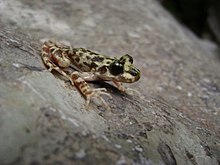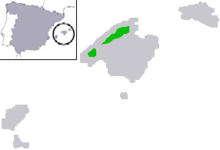Alytes muletensis
| Majorcan midwife toad | |
|---|---|
 |
|
| Scientific classification | |
| Kingdom: | Animalia |
| Phylum: | Chordata |
| Class: | Amphibia |
| Order: | Anura |
| Family: | Alytidae |
| Genus: | Alytes |
| Species: | A. muletensis |
| Binomial name | |
|
Alytes muletensis (Sanchiz & Adrover, 1977) |
|
 |
|
The Majorcan midwife toad (Alytes muletensis) (also Mallorcan midwife toad or ferreret in Balearic Catalan and Spanish) is a frog in the family Alytidae (formerly Discoglossidae). It is endemic to the Balearic Island of Majorca in the Mediterranean Sea. An example of Lazarus taxon, the species was first described from fossil remains in 1977, but living animals were discovered in 1979.
The species, considered "vulnerable" by the IUCN, is currently restricted to isolated mountain rivers in the island's Serra de Tramuntana and has an estimated population of 500 breeding pairs in the wild. It does exist and reproduce easily in captivity, however. The Majorcan midwife toad is thought to have disappeared from most of the island as a result of the introduction of competitors and predators from the mainland in ancient times. Reintroduction of the species in additional areas has taken place since 1988, with many new breeding populations now well established.
Like all midwife toads, the male of the species always carries the developing eggs during the months of May and June. Generally the head and legs are large in comparison to the rest of the body. Unusually, the female of the species competes for the male, even grappling against other individuals in order to secure a mate. Both male and female frogs use a series of noises in order to attract a mate during courtship. Comparatively the female is larger than the male (Male: 34.7 mm, Female: 38mm).
The species is endemic to Majorca, and is found only in the mountainous regions and gorges of the Serra de Tramuntana. In this area, the species inhabits streams in limestone caverns, where they hide under boulders and stones.
...
Wikipedia

